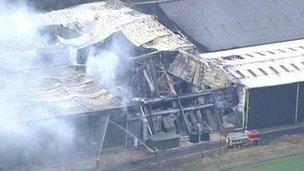Atherstone warehouse fire: Search for firefighters
- Published

Chief Fire Officer Jon Hall said the crews had not dealt with anything on the scale of Atherstone before
A large search and rescue operation was triggered in 2007 when firefighters wearing breathing apparatus failed to re-emerge from a warehouse fire in Warwickshire.
Ian Reid, 44, Ashley Stephens, 20, John Averis, 27, and Darren Yates-Badley, 24, died as a result of the fire at the vegetable packing plant on Atherstone Industrial Estate on 2 November.
Their deaths represent the greatest loss of life among British firefighters in a single incident for 30 years.
On Wednesday two fire officers, Timothy Woodward, 51, and Adrian Ashley, 45, were found not guilty of manslaughter over the incident.
The four firefighters, from Warwickshire, had entered the building wearing breathing apparatus after the fire had started at about 18:45 GMT.
Rugby-based firefighter Mr Reid was the first to be rescued from the warehouse, in a "disorientated and panicked" state in a smoke-filled storage area. He died later in hospital.
'Couldn't trust anything'
His three colleagues were reported missing when they failed to re-appear at about 19:30 GMT, the time their oxygen tanks would have run out.
Prosecutor Richard Matthews QC said the men had died for "no good reason" as no-one else was inside the building when they were sent in.
The building itself contained only cardboard boxes, labels and old furniture.
Within 90 minutes other fire officers had located the bodies of two of their colleagues on the first floor but had to suspend the rescue operation as the building had become too unstable to continue.
Chief Fire Officer Jon Hall, from Gloucestershire Fire and Rescue Service, led the search for the firefighters.
He said: "Nobody had ever dealt with a failing building on that scale in the UK.

Ashley Stephens, Darren Yates-Badley and John Averis died in the plant, Ian Reid died in hospital
"It was a complete spaghetti mess of metal, falling wires and burning timber wall partitions.
"This bore no resemblance to a building you or I recognise, this was just a complete mess they were being committed into.
"It was bad enough but they couldn't trust anything they stood on."
Crews mainly had to tackle the fire from the roof which was caving in where they stood.
The team included specialist officers who had worked at the centre of the 2005 South Asian earthquake that killed an estimated 75,000 people in Pakistan and Pakistan-administered Kashmir.
'Immensely difficult'
But not even they had the experience to deal with a building collapse on the scale of Atherstone.
The response team turned to structural engineers who had previously dealt with aircraft hangar demolitions to help.
Together the teams built a new floor above ground level so officers could move forward safely through the building to search for their missing colleagues.
"They rebuilt the floor 20m above the ground - that would take construction workers weeks if not months to do, our crews did it in a matter of days," Mr Hall said.
High winds hampered the search effort by further destabilising the building's structure.
In addition to the difficult conditions, the crews had to deal with the knowledge and pressure they were searching for fellow firefighters.
Mr Hall said positive psychology had played a significant role in the way they had approached the operation.

High winds hampered the search and rescue effort by further destabilising the building's framework
"It was emotional but if you think in fire and rescue we are going in to do a body recovery that would affect the way you operate," he said.
"The truth is that we always treated it like a live rescue and apart from ensuring the safety of the firefighters and the technicians going in there, the whole country was treating it as though we were rescuing live casualties."
However, the rescuers knew their colleagues' air tanks would have run out shortly after 19:28 GMT on the first night and their chances of survival were slim.
Mr Hall added: "The fire service reacted as one, from the most junior operational person right up to the secretary of state. 'Actually don't care what it takes Jon', was the message I was getting, 'get those firefighters out'."
- Published20 January 2012
- Published2 November 2010